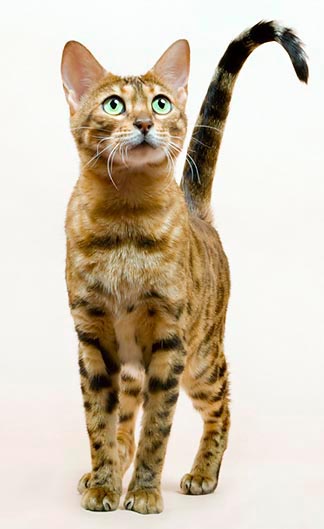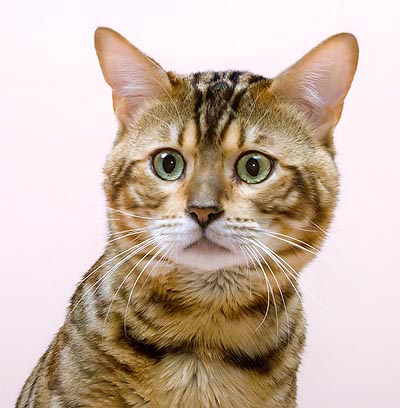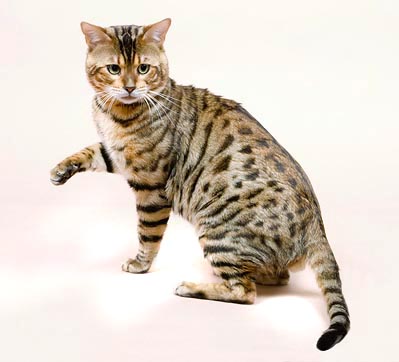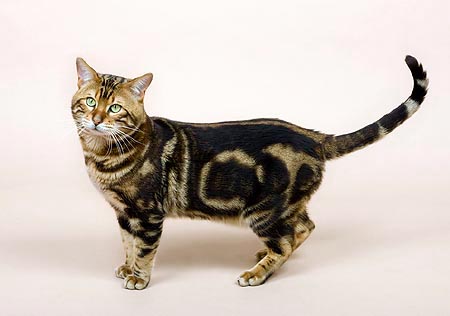Family : Felidae

Text © Dr Didier Hallépée

English translation by Mario Beltramini

Lively, intelligent, curious and affectionate © G. Mazza
During the first part of the twentieth century, some observations about crossings between domestic cats and wildcats were published and relevant experiments took place.
During the sixties, several leopard cats or Bengal cats (Felis bengalensis) have been imported in the USA in particular as domestic animals and also there crossings experiments are done. It is during those years that come to life some clubs which want to encourage the hybridization of the domestic cat with the wild cats. The term “Bengal” begins to be utilized for describing these cats.
During those years, pharmacological researches utilize the hybridization between the leopard cat and the domestic cat for immunology researches against the feline leukemia.
One of the scientists having taken part to these experiments, Jean Sugden (later Jean Mill) thought, during the seventies, to take advantage of the interest these hybrids might create, for fighting against the utilization of the feline furs in the clothing industry. In 1980, she was able to collect her first four leopard cats from a laboratory which had utilized them in the context of its immunology researches. In this way, she began her hybridization works.
The male specimens born from the hybridization are sterile during several generations. It is therefore necessary to utilize domestic male cats for these first generations. Being a breeder of the Egyptian Mau, her choice oriented her naturally towards this cat whose spotted pattern might naturally allow in conserving the pattern of the leopard cat.
One of her trips brought her to the zoo of New Delhi. There, just in front of the cage of the leopard cats, was the enclosure of the rhinos. And with them lived two tabby cats with copper colours which had reported to her by her friend, the director of the zoo. These cats, Toby and Tash of New Delhi, were taken to USA, recognized as Egyptian Mau and utilized in the programme of creation of the Bengal and in a programme of enrichment of the colour of the bronze Egyptian Mau. The first generations which came were at times declared as Mau and at times as Bengals. The great adventure of the Bengal had finally started. The breed was recognized as experimental breed in 1983. Beyond the Egyptian Mau, other breeds of domestic cats have been utilized for creating the Bengal, particularly the Burmese, the Siamese, the Abyssinian and the domestic cat.

The head is quite different from that of a domestic cat © G. Mazza
During the eighties, other hybridization experiments took place, particularly the crossing of the domestic cat with the Margay ( Felis wiedii ) under the name of Bristol cat. The last Bristol cats were inserted into the Bengal breed in 1991 with the aim to widen the genetic patrimony. Incidentally, this contribution facilitated the obtainment of rosettes in the pattern.
The Bengal has been victim of a fashion phenomenon which has involved an important production by breeders of different competence. So, some of them consider the breed as moderately stabilised, both on the morphology point of view and on the character one. However, the quality breeders produce cats in conformance with the standard, of great beauty and pleasing character.
The intensive utilization of the Egyptian Mau for creating a breed has at times led to cats whose appearance reminded very much the Egyptian Mau. These cats are still met in the farming where the quality production is not the main worry. The good quality Bengal, conform to its standard, does not any more look like the Egyptian Mau.
Character
Specimens born from hybridization of a wild cat and a domestic cat are called F1. The specimens of the following generation are called F2. And so on.
In hybridization, the males are sterile during several generations (4 to 6), from where comes the utilization of domestic cats as male reproducers to create a new line. The generations F1 to F3 are considered as wild, forbidden in the expositions and subjected to specific dispositions concerning their detention.
Depending on the lines, the F4 to F6 Bengals can be not totally stabilised on the morphology or character points of view.
The specimens too close to their wild ancestors can reveal timid and, at times, scary. This trait of character disappears when the number of generations separating them from the ancestors is sufficient.
The Bengal is lively, intelligent, curious, sportive, talkative and very affectionate, especially with other animals and with kids. It loves the water and particularly appreciates to stand on height.

Bengal – Brown Spotted Tabby © Giuseppe Mazza
Standard
The head, with rounded contours, forms a triangle, longer than wide. It is rather small compared to the body, but without exaggeration. The expression of the head of the Bengal must be as much as possible distant from that of a domestic cat. The curve of the front, slightly rounded, joins gently the stop of the nose, without interruption, and goes on in a practically straight to slightly convex line up to the end of the nose. The cheeks are high and marked. The nose is wide with a typical bulging skin. For the males, the jowls are authorized.
The muzzle is formed by very developed whiskers which generate a slight pinch. In profile, the strong chin is aligned with the tip of the nose.
Big, well spaced, the eyes are oval, almost round but never globular. The colour of the eyes is the green, the gold, the blue or the aquamarine, depending on the colour of the mantle. The deepest and most brilliant tonality is the most appreciated.
Of medium to small size, the ears are rather short, with a wide base and the rounded extremity. They are spaced by the length of one ear. In profile, the point forwards. The “lynx tips” are unwanted.
The neck is long, muscled and well attached. Body: long, it well muscled, well evident, and a robust framing. This gives the Bengal a look of a powerful but graceful cat.
The legs, of average length and well muscled, have a robust bone framework.
Big and round, the feet of the Bengals have prominent toes.
Average to short, the tail is thick at the base, getting little thinner and ending in a rounded extremity.
The fur is short, thick, well distributed on the body and exceptionally sweet and silky to touch. The fur can be somewhat powdered of gold, effect called “glitter”, without rendering this tonality advantaged in comparison to a chat not provided of “glitter”.
Spotted pattern and rosettes: two types of dots are admitted, the rosettes and the spots, which are placed at random or aligned horizontally. The rosettes are composed of at least two different colours and can have the shape of a print of paw, or of an arrowhead or of a ring. They are preferred to the simple spots but cannot be required. Whether spots or rosettes, the contrast with the background colour must be extreme, with distinct forms and rims. The shoulders are covered by mottling, whilst the legs and the tail are maculated or ringed. The belly is imperatively maculated. On the head, the typical make-up of the tabby cats is strongly marked. The whiskers, the throat, the bottom of the hair of the belly, the interior of the paws are whitish, the palest possible.
The spotted patterns en rosettes concur both in the same class.

Bengal – Brown Marble © Giuseppe Mazza
The marble pattern differs from the tabby blotched one. Here, the classical marks (oyster shell, butterfly wing) are elongated horizontally so much to resemble to the veins of the marble or to the marks of the clouded leopard. The bands of the base colour must be as large as the veins; they also are closer at the centre. The preference must be given to the mantles presenting at least three tones: the base colour, the colour of the marks and the intense colour underlining these marks. The contrast must be extreme. The belly must imperatively have drawings. On the head, the typical make-up of the tabby cats is strongly marked. The whiskers, the throat, the base of the hair on the belly and of the interior of the paws are whitish, the palest possible.
Coat
Patterns: spotted, rosettes, marble.
Colours: black (brown, silver, smoke), blue.
→ For general notions about Felidae please click here.
→ To appreciate the biodiversity within the CAT BREEDS please click here.
